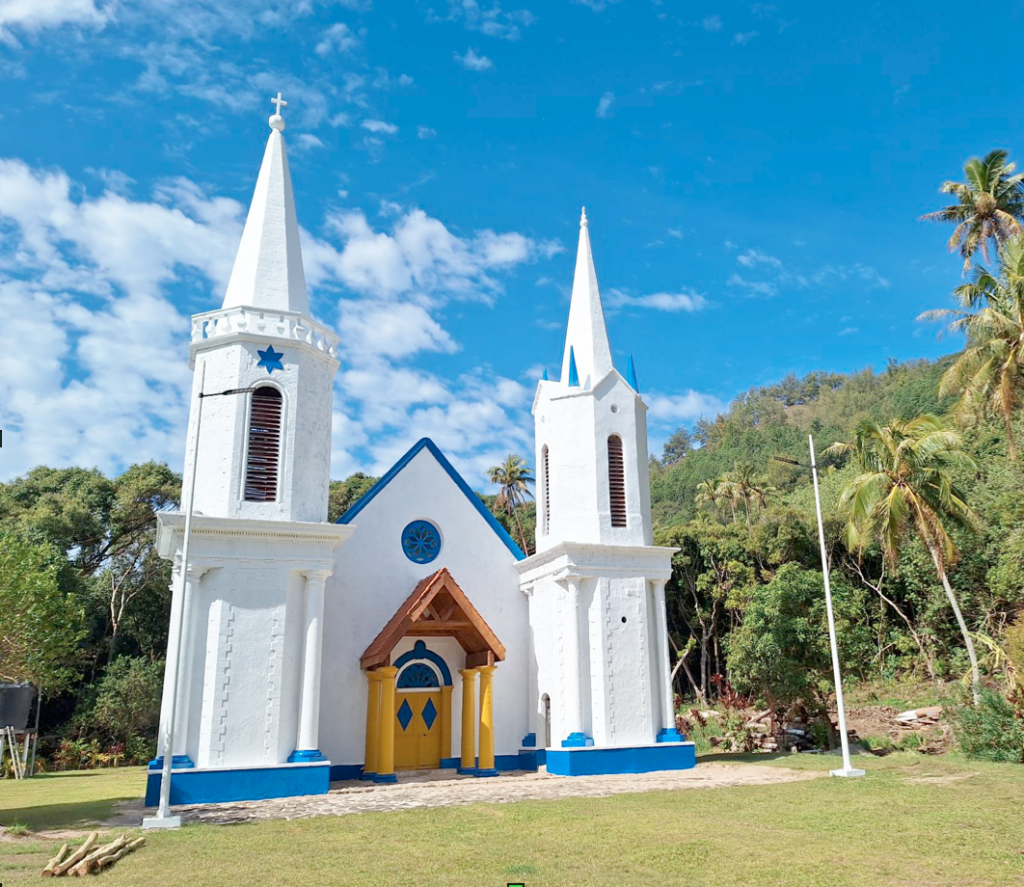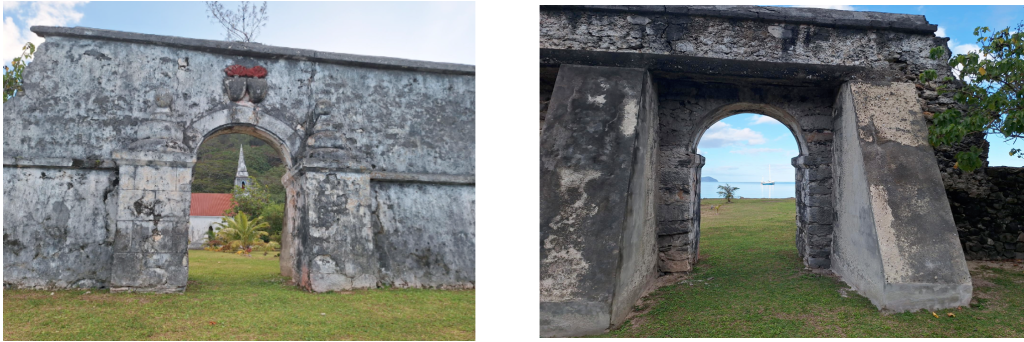Characteristic of the islands in Gambier are the white churches and chapels. All Catholic. The services are in Managerevian and French, and some parts even in Latin. How did Catholicism reach these islands and root so firmly that this religion seems still very much alive in Gambier today?

Altar of St. Michael’s Cathedral, Rikitea, with the Sacred Hearts of Mary and Jesus and mother-of-pearl decorations.
The penultimate king of Mangareva and the Gambier islands, Te Maputeoa Gregorio I , played an important part here. He ruled during the transition from traditional beliefs to Catholicism. To avoid a coup by his uncle, he sought the protection of the church. He even agreed to dismantle the traditional sacred place Te Keika marae in Rikitea, so that St Michael’s Cathedral could be built here. So, now we know the roots, and we know the marriage of church and state creates deep roots. But how to keep these roots alive now the last king died more than a century ago?
Mangareva: Rikitea
The centre of religious activity in Gambier is St Michael’s Cathedral in Rikitea, the capital of Mangareva. It is the largest in Gambier. The two hearts that you find in al churches (see picture of the altar in the Cathedral above) refer to the Congregation of the Sacred Hearts of Jesus and Mary. This was the order of the founding missionaries, Honoré Laval and François Caret.

St. Michael’s Cathedral in Rikitea
The priest of St. Michael’s Cathedral is an energetic man who engages the whole community in the service. The lyrics of the songs are shown on a powerpoint so even guests can sing along. Some illustrations of Jesus, Mary and the pope flash by. A lady in white plays a central role in the sermon: she directs the singing. And, during the sermon, several members of the church, also dressed in white, take on parts of the service by telling their stories. They put their hearts in it, which makes it really personal.
This is not the ‘one-man-show’, typical of the traditional catholic sermon. With this priest firmly rooted in his community, we are not surprised to find him working on a construction site. When we greet him, we ask him about the procession of the statue of Notre Dame de Paix from Akamaru to Rikitea. He explains that the statue is already in Rikitea, this will be celebrated 15th of August.

Statues of Holy Mary in St. Michael’s Cathedral, Rikitea
Akamaru
So, when we visit Akamaru Island, we know we will not find the famous statue. However, the church of Notre Dame de Paix is in beautiful condition, and the garden and lanes look great. The lady who meets us, tells us that all churches in Gambier were built in approximately the same time. The missionaries supervised the jobs going from island to island. Our hostess proudly adds that the Notre Dame de Paix was the first to be inaugurated, because Akamaru was the landing place of Honoré Laval and François Caret in 1834. This is probably also why the statue of Notre Dame de Paix plays such an important role in the yearly procession from Akamaru to Rikitea and back.

Freshly painted church of Notre Dame de Paix in Akamaru
When we arrived, the islanders had just finished painting the church for the festivities of the pilgrimage. The population of Akamaru consists of approximately 10 persons, but, as our hostess explains, fortunately there is always someone who can say the mass. And in return, the islanders take really good care of their church.

Altar of Notre Dame de Paix in Akamaru, with some flowers on the empty spot of the statue
Taravai
Bob Marly’s song ‘one love’ accompanies us on our evening walk on Taravai Island. During the festivities for ’14 Juillet’ we supported the restoration of the church by buying some delicious traditional food (poisson cru, cooked yams, breadfruit, bananas, and a pork stew). And indeed, this church dearly needs maintenance. It is in progress, but we hope the termites respect the work as much as we do.

Sacred Hearts on the walls guarding the church in Taravai; Ya seen through the gate of the wall

Sacred Hearts in Taravai’s church
Our guess: the roots are in the hearts
The missionaries of the congregation of the Sacred Hearts of Jesus and Mary engaged the whole population of the Gambier Islands in building the churches. Mangareviens are still proud of having played a central part in building the cathedral in Tahiti. By engageing them, the missionaries have embedded the Catholic belief in the hearts of the men and women of Gambier. And this continues in the way the priest and his helpers share the care for the religion, traditions and buildings with the community. This keeps the roots strong.
